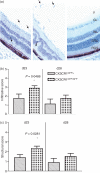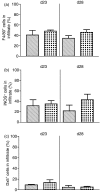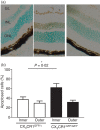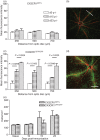CX3CR1-deficiency is associated with increased severity of disease in experimental autoimmune uveitis
- PMID: 19689733
- PMCID: PMC2747136
- DOI: 10.1111/j.1365-2567.2009.03046.x
CX3CR1-deficiency is associated with increased severity of disease in experimental autoimmune uveitis
Abstract
The role of CX3CR1 in regulating the function of monocytes and microglia was examined in mice in which CX3CR1 had been replaced by green fluorescent protein (GFP). Induction of experimental autoimmune uveitis (EAU) in these mice resulted in increased disease severity at day 23 postimmunization with uveitogenic peptide when compared with CX3CR1-positive mice and increased apoptosis of neuronal cells in the inner nuclear layer. Resident microglia within the retina were activated equally as EAU developed in mice with or without CX3CR1, as determined by changes in morphology, suggesting that the microglial cell response did not account for the differences. Although the inflammatory infiltrate had increased in mice without CX3CR1 at day 23 postimmunization, the percentage of natural killer cells in the infiltrate was not changed in these mice. Similarly, increased disease severity at this stage was not associated with an overall increased percentage of macrophages in the retinal inflammatory infiltrate or in increased activation of these cells. The increased recruitment of monocytes to the retina in response to EAU induction in CX3CR1(GFP/GFP) mice compared with CX3CR1(GFP/+) mice was not reflected in increased migration away from vessels, leading to marked clustering of GFP(+) cells around veins and venules in these mice. It is possible that this monocyte/macrophage clustering leads to the increased severity of disease seen in the mice by focusing and so intensifying the inflammatory response.
Figures





Similar articles
-
In vivo multi-modal imaging of experimental autoimmune uveoretinitis in transgenic reporter mice reveals the dynamic nature of inflammatory changes during disease progression.J Neuroinflammation. 2015 Jan 27;12:17. doi: 10.1186/s12974-015-0235-6. J Neuroinflammation. 2015. PMID: 25623142 Free PMC article.
-
The monocyte chemokine receptor CX3CR1 does not play a significant role in the pathogenesis of experimental autoimmune uveoretinitis.Invest Ophthalmol Vis Sci. 2010 Oct;51(10):5121-7. doi: 10.1167/iovs.10-5325. Epub 2010 May 12. Invest Ophthalmol Vis Sci. 2010. PMID: 20463325
-
Experimental autoimmune uveoretinitis (EAU)-related tissue damage and angiogenesis is reduced in CCL2⁻/⁻CX₃CR1gfp/gfp mice.Invest Ophthalmol Vis Sci. 2014 Oct 23;55(11):7572-82. doi: 10.1167/iovs.14-15495. Invest Ophthalmol Vis Sci. 2014. PMID: 25342612
-
Microglial mediators in autoimmune Uveitis: Bridging neuroprotection and neurotoxicity.Int Immunopharmacol. 2024 Jul 30;136:112309. doi: 10.1016/j.intimp.2024.112309. Epub 2024 May 29. Int Immunopharmacol. 2024. PMID: 38810304 Review.
-
Microglial-mediated immune mechanisms in autoimmune uveitis: Elucidating pathogenic pathways and targeted therapeutics.J Neuroimmunol. 2024 Oct 15;395:578433. doi: 10.1016/j.jneuroim.2024.578433. Epub 2024 Aug 14. J Neuroimmunol. 2024. PMID: 39168018 Review.
Cited by
-
Targeted Gene Candidates for Treatment and Early Diagnosis of Age-Related Macular Degeneration.Biomed Res Int. 2021 Feb 2;2021:6620900. doi: 10.1155/2021/6620900. eCollection 2021. Biomed Res Int. 2021. PMID: 33604378 Free PMC article.
-
The blood-brain barrier, chemokines and multiple sclerosis.Biochim Biophys Acta. 2011 Feb;1812(2):220-30. doi: 10.1016/j.bbadis.2010.07.019. Epub 2010 Aug 6. Biochim Biophys Acta. 2011. PMID: 20692338 Free PMC article. Review.
-
Retinal microglia initiate neuroinflammation in ocular autoimmunity.Proc Natl Acad Sci U S A. 2019 May 14;116(20):9989-9998. doi: 10.1073/pnas.1820387116. Epub 2019 Apr 25. Proc Natl Acad Sci U S A. 2019. PMID: 31023885 Free PMC article.
-
Targeting Microglia to Treat Degenerative Eye Diseases.Front Immunol. 2022 Feb 17;13:843558. doi: 10.3389/fimmu.2022.843558. eCollection 2022. Front Immunol. 2022. PMID: 35251042 Free PMC article. Review.
-
In vivo multi-modal imaging of experimental autoimmune uveoretinitis in transgenic reporter mice reveals the dynamic nature of inflammatory changes during disease progression.J Neuroinflammation. 2015 Jan 27;12:17. doi: 10.1186/s12974-015-0235-6. J Neuroinflammation. 2015. PMID: 25623142 Free PMC article.
References
-
- Kim SU, de Vellis J. Microglia in health and disease. J Neurosci Res. 2005;81:302–13. - PubMed
-
- Rot A, von Andrian UH. Chemokines in innate and adaptive host defense: basic chemokinese grammar for immune cells. Annu Rev Immunol. 2004;22:891–928. - PubMed
-
- Sunderkotter C, Nikolic T, Dillon MJ, et al. Subpopulations of mouse blood monocytes differ in maturation stage and inflammatory response. J Immunol. 2004;172:4410–7. - PubMed
-
- Gordon S, Taylor PR. Monocyte and macrophage heterogeneity. Nat Rev Immunol. 2005;5:953–64. - PubMed
-
- Geissmann F, Jung S, Littman DR. Blood monocytes consist of two principal subsets with distinct migratory properties. Immunity. 2003;19:71–82. - PubMed
Publication types
MeSH terms
Substances
LinkOut - more resources
Full Text Sources
Other Literature Sources
Medical
Molecular Biology Databases

